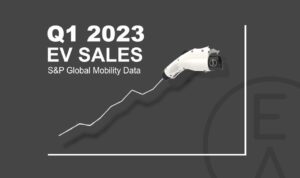Battery electric vehicle registrations accounted for the entire decline, posting a 6.9 per cent market share, down from 8.4 per cent in Q4 2022

ZEV registrations in Canada declined in Q1 after hitting a record high in Q4 2022
Battery electric vehicle registrations accounted for the entire decline, posting a 6.9 per cent market share, down from 8.4 per cent in Q4 2022
Zero-emission vehicle (ZEV) registrations in Canada lost a full percentage point of market share in the first quarter of 2023 after hitting a record high in Q4 of last year.
According to new data published by S&P Global Mobility, the combined market share of battery electric vehicles (BEV) and plug-in hybrid electric vehicles (PHEV) in Q1 was 9.1 percent, down from 10.2 per cent in Q4.
Battery electric vehicles accounted for the entire decline, making up just 6.9 per cent of new vehicle registrations compared to 8.4 per cent in Q4. The market share for PHEVs actually increased slightly, to 2.2 per cent from 1.8 per cent in Q4.
S&P Global cites “various factors” contributing to the decline in ZEV registrations across Canada. Most striking is the loss of market share for Tesla.
“Historically Tesla accounted for 40% to 50% of the volume within the ZEV segment,” writes S&P Global in its quarterly Canadian Automotive Insights summary. “However, Tesla registrations dropped by 30% in the quarter, and its market share landed at 30%…marking its lower quarterly share since Q3 2021.”
Ford Canada’s market share in the ZEV sector also declined, falling by 4 percentage points, says S&P Global.
(Note: S&P Global, like Statistics Canada, classifies BEVs and PHEVs as “zero-emission vehicles.” The grouping does not reflect Electric Autonomy‘s view, which considers only non-combustion engine vehicles to be zero-emission. However, where statistics in this report refer to ZEVs, we have adhered to the S&P Global definition for consistency.)
Ontario saw substantial drop
At the provincial level, the story is somewhat mixed.
ZEV market share in B.C. continued to lead the country, with a 19.7 per share, down slightly from 20.1 per cent in Q4.
Quebec again showed a strong second, with a 14.4 per cent share, down very slightly from 14.6 % in Q4.
It’s in Ontario, however, where the market really cratered. ZEV registrations in the province in Q1 posted just a 6.2 per cent market share, down from 8.3 per cent in Q4 — a 25 per cent quarterly decline.
Two of the biggest gainers among the provinces were P.E.I. and Nova Scotia, with ZEV market share hitting 5.6 per cent and 5.3 per cent respectively, compared to 3.5 per cent and 3.6 per cent in Q4.
S&P Global’s analysis also suggests that the Q1 results point to “potential challenges ahead,” citing inflationary pressures as a potential concern. However, as year-over-year inflation rates in Q1 were lower than the second half of 2022, other factors might also play a role.
At the same time, S&P Global says it stands by its long-term bullish outlook for ZEV market share growth, noting its March 2023 projection for ZEVs to reach 16 per cent market share in 2024.






